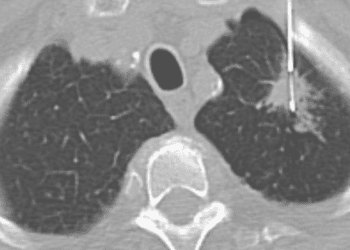CT scans linked to cancer risk in children
Image: PD
1. Exposure to CT scan radiation was found to be associated with cancer.
2. Brain cancer risk associated with CT scans was higher than all other cancers.
Evidence Rating Level: 2 (Good)
Study Rundown: The use of diagnostic computed imaging provides valuable information for clinicians, but also exposes patients to low doses of radiation. This cohort study is the largest of its kind analyzing the incidence of cancer in individuals aged 0-19. Researchers compared incidence rates in 680,000 individuals exposed to CT scans, to a cohort of >10 million individuals not exposed to a CT scan. Incidence rate ratios (IRRs) were used to compare the risk between populations (controlling within the population for age, sex, average dosages and year of birth).
The incidence rate ratio for all types of cancer was 1.24 (95% CI 1.20-1.29) in the exposed population compared to the unexposed population. Furthermore, risk for brain cancer had the highest IRR (2.41) followed by digestive organs (1.85), soft tissue (1.78), and lymphoid (1.70). Researchers admit that they were limited by their knowledge of dosages and varying CT machine parameters, however this data significantly improves upon previous epidemiological studies investigating outcomes associated with radiation from the Chernobyl incident and the Japanese atomic bomb. Epidemiological data on this scale sheds light on a tension between clinical diagnostic value of CT scans and the risk of irradiation linked to cancer.
Click to read the study in British Medical Journal
In-Depth [population cohort analysis]: Data from this study was gathered from electronic medical records of Australian patients born between 1985 and 2005.
Researchers also identified a number of additional findings. 1.) Children younger than five had the highest IRR with risk inversely associated with increasing age. 2.) Cancer risk declined with the amount of time after a patient’s first exposure; however even fifteen years after the initial exposure, cancer risk still remained significantly higher for patients compared to the control (1.22).
Although researchers found that brain cancer was the highest association, they also recognized that 60% of the scans were of the brain. This correlation caused unease as to whether the cancer may have developed before the scan, rather than the scan causing the cancer. To control, researcher excluded this population from the analysis, but despite excluding these reverse causation cases, the IRR for all cancers remained significantly increased (1.20).
By Jordan Anderson and Andrew Bishara
More from this author: Slowdown in healthcare costs linked to economic and clinical factors; Breast implants linked with later stage breast cancer, mortality; Contraband tobacco leads to reduced smoking cessation; Circulating tumor DNA used to monitor metastatic breast cancer; Salt intake linked with autoimmune disease; Continuity in diabetes provider improves outcomes and decreases costs;
© 2013 2minutemedicine.com. All rights reserved. No works may be reproduced without written consent from 2minutemedicine.com. Disclaimer: We present factual information directly from peer reviewed medical journals. No post should be construed as medical advice and is not intended as such by the authors or by 2minutemedicine.com. PLEASE SEE A HEALTHCARE PROVIDER IN YOUR AREA IF YOU SEEK MEDICAL ADVICE OF ANY SORT. Content is produced in accordance with fair use copyrights solely and strictly for the purpose of teaching, news and criticism. No benefit, monetary or otherwise, is realized by any participants or the owner of this domain.


![2MM: AI Roundup- AI Cancer Test, Smarter Hospitals, Faster Drug Discovery, and Mental Health Tech [May 2nd, 2025]](https://www.2minutemedicine.com/wp-content/uploads/2025/05/Untitled-design-350x250.png)




